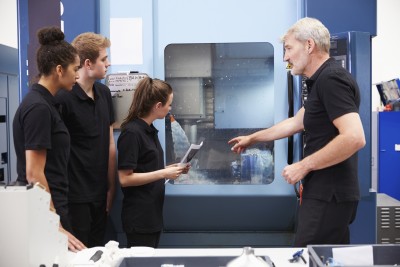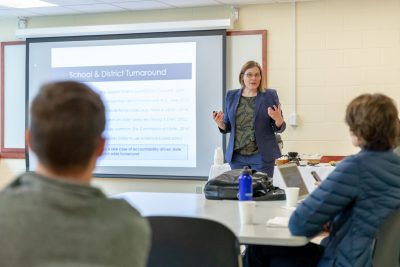
Editor’s Note: Samuel J. Kamin, a doctoral student in the Learning, Leadership, and Education Policy program at the Neag School, prepared the following issue brief on career and technical education in affiliation with the Center for Education Policy Analysis (CEPA), a research center based at the Neag School that seeks to inform educational leaders and policymakers on issues related to the development, implementation, and consequences of education policies.
Both the means and the ends of American public education have long been debated by scholars, politicians, practitioners, and the public. Most stakeholders have come to agree that preparing students for both college and career is an obvious yet difficult goal. Career and Technical Education, or CTE, is one educational pathway that connects both of these goals. CTE programs offer both pre-service career training and opportunities to develop the skills necessary for success in college.
Is CTE meeting its goal to prepare students for career and college? A brief review of the limited literature suggests current CTE offerings may be beneficial for both professional and postsecondary outcomes. Further, current research provides one particularly salient and policy-relevant conclusion: students who take in-depth coursework in a single CTE program of study see particularly strong academic and career-oriented results.
Is career and technical education (CTE) meeting its goal to prepare students for career and college?
What Is CTE?
CTE programs integrate traditional high school coursework with career preparatory courses that build students’ technical skills in a variety of areas. This can range from the modern iterations of classic vocational courses in construction and mechanics to new, 21st century skills in computer science and engineering. Students may take a variety of courses, or “concentrate” by taking three or more courses in a program of study. Frequently, students participate in partnerships with local employers and/or take certification exams in their field. The amount of CTE coursework each student completes varies widely and depends on the program. In a typical, comprehensive high school, students may take one or two elective CTE courses as part of their regular curriculum.

At “technical” high schools, all students participate in a CTE program. Thus, academic and traditional coursework may be distinct from each other. For example, at some regional vocational technical schools (RVTS) in Massachusetts, students alternate weekly between their traditional coursework and technical CTE instruction.[i] Some districts offer a hybrid approach in which students take academic work at a traditional high school, and vocational/technical courses at a designated technical center.
CTE programs vary widely both between and within states and districts, but national trends exist. First, programs are typically grouped into “career clusters” at the state or district level. Both the number and type of clusters vary, but the general purpose is the same: to encourage students to focus on a particular set of courses that align with a particular career path. For example, clusters in Maryland include Arts, Media, and Communication, Information Technology, Construction and Development, and Health and Biosciences.[ii] Clusters may be developed by state or district-level CTE program offices or adopted in collaboration with national programs and advocacy groups.
A second and related trend is the development of “pathways” in CTE.[iii] These pathways are designed to support students’ progression through their secondary academic careers with specific benchmarks. These benchmarks may include the completion of a specific sequence of courses, the attainment of a field-specific technical certificate or credential, work-based learning experiences, or advanced, pre-college coursework. Pathways may be directly or informally associated with the clusters described above, and similar to clusters, may be locally developed by states or districts, or as branded programs that are developed in collaboration with national non-profit organizations.[iv]
Who Participates in CTE?
A significant portion of American high school students participate in CTE programs. As of 2009, the National Center for Education Statistics reports that almost 90 percent of students have at least one credit in a CTE area. In addition, more than half of students have at least 3 credits and more than one in four have five or more. Those with more credits are more likely to have taken occupational education courses, which encompass a wide variety of specific training, as opposed to courses in family and consumer sciences, or “general labor market preparation.”[v]
 Students in these CTE programs and courses do not mirror the student population as a whole. Indeed, CTE has yet to shake the echoes of ability-based tracking that were clearly evident in 20th-century vocational education. Historically, males, students with high-incidence disabilities, low-income students, and students of color have been overrepresented in CTE programs.[vi] Trends exist within CTE program choices as well and societal issues are mirrored in students’ selection of pathway and cluster. For example, male students in Arkansas are overrepresented in manufacturing, but underrepresented in education and health sciences. Other student demographic trends exist that are worth monitoring as well.[vii]
Students in these CTE programs and courses do not mirror the student population as a whole. Indeed, CTE has yet to shake the echoes of ability-based tracking that were clearly evident in 20th-century vocational education. Historically, males, students with high-incidence disabilities, low-income students, and students of color have been overrepresented in CTE programs.[vi] Trends exist within CTE program choices as well and societal issues are mirrored in students’ selection of pathway and cluster. For example, male students in Arkansas are overrepresented in manufacturing, but underrepresented in education and health sciences. Other student demographic trends exist that are worth monitoring as well.[vii]
Is CTE Working? Exploring the Value of In-Depth Coursework
There are two core categories of metrics by which to judge the success of CTE programs: career preparation and academic attainment. Further, the variety of participation and models of CTE may help provide some clues as to what types of CTE delivery are most beneficial, in what ways, and for whom. At this point, evidence across the board is generally mixed. However, one key trend has emerged: Students who take in-depth CTE coursework see academic and career-oriented benefits more consistently than other CTE students or similar students in non-CTE settings.
One key trend has emerged: Students who take in-depth CTE coursework see academic and career-oriented benefits more consistently than other CTE students or similar students in non-CTE settings.
Current literature suggests the gains in both academic and career-oriented metrics are tied to students’ in-depth concentration on particular CTE skills, supported by clusters or pathways. For example, recent research indicates that the value of CTE coursework on wages depends on advanced coursework in a particular field, and that each additional year of advanced coursework yields a 2 percent increase in wages. By contrast, there is no gain from introductory courses.[viii] Moreover, in Arkansas, CTE students who “concentrate” (took three or more courses) in an aligned “program of study” (similar to a pathway) saw higher graduation rates when compared to similar students who took the same number of CTE courses without alignment.[ix] Recent analysis also suggests that CTE courses taken later in high school are especially linked to lower chances of dropout and increased high school graduation, suggesting students who persist in taking CTE courses throughout high school may see these specific benefits rather than those that take courses only at the end of their high school program?.[x]
The methods of such in-depth study may be relevant as well. For example, students in the RVTS system in Massachusetts, in which all students take in-depth CTE coursework, saw higher graduation rates, higher likelihood of earning professional credentials, and similar probability of passing the required graduation exams when compared to similar students at traditional comprehensive high schools, despite spending significantly less classroom time on traditional subjects.[xi]
These gains from in-depth CTE coursework might be particularly important for students who are less likely to graduate from high school. Results from the RVTS system in Massachusetts show that students eligible for free or reduced-price lunch experienced greater benefits than other students in RVTS schools.[xii] Similarly, students with high-incidence disabilities were also more likely to graduate from high school within four years that similar students in non-CTE settings.[xiii]
Policy Recommendations
In conclusion, when considering the value of in-depth CTE coursework, there are three policy recommendations for school, district, and state leaders considering the value of Career and Technical Education:
- Expand and encourage “concentration” in in-depth CTE coursework: Although CTE has mixed success in general, there are clear benefits for students who take in-depth coursework in CTE subjects. These students attain increased graduation rates and wages, and these effects appear to be particularly notable for historically disadvantaged groups, namely low-income students and students with disabilities.
- Develop and adopt clusters and/or pathways that support student learning and curricular choice: CTE can take many forms; states and districts who adopt a cluster and/or pathways approach to delivery will encourage students to take more in-depth CTE coursework, and thus produce the most positive effects.
- Encourage students to go beyond clusters and pathways traditionally associated with “students like them”: While CTE maintains a negative association with the low-track, vocational programs of the past, CTE can be a path to college, not a path away from it. Further, CTE offerings present the opportunity for students to go in-depth in experiences that may not be traditionally associated with students of their gender, race, or socioeconomic status. CTE can (and should) be a mechanism to shift past social mores, not reinforce them.
Learn more about CEPA at cepa.uconn.edu. Access this issue brief, as well as other CEPA presentations and publications, in PDF format here.
Related Stories:
- Preparing a School District for a 1:1 Technology Initiative: Issue Brief
- The Impact of Undocumented Status on Children’s Learning
References
Dougherty, S. M. (2016). Career and Technical Education in High School: Does It Improve Student Outcomes? Fordham Institute. Retrieved from edexcellence.net/publications/career-and-technical-education-in-high-school-does-it-improve-student-outcomes
Dougherty, S. M. (2018). The Effect of Career and Technical Education on Human Capital Accumulation: Causal Evidence from Massachusetts. Education Finance and Policy, 13(2), 1–30. doi.org/10.1162/edfp_a_00224
Dougherty, S. M., & Lombardi, A. R. (2016). From Vocational Education to Career Readiness: The Ongoing Work of Linking Education and the Labor Market. Review of Research in Education, 40(1), 326–355. doi.org/10.3102/0091732X16678602
Gottfried, M. A., & Plasman, J. S. (2017). Linking the Timing of Career and Technical Education Coursetaking With High School Dropout and College-Going Behavior. American Educational Research Journal, 0002831217734805. doi.org/10.3102/0002831217734805
Hehir, T., Dougherty, S., & Grindall, T. (2013). Students with disabilities in Massachusetts Career and Technical Education programs. Commonwealth of Massachusetts, Department of Elementary and Secondary Education.
Kreisman, D., & Stange, K. (2017). Vocational and Career Tech Education in American High Schools: The Value of Depth Over Breadth(Working Paper No. 23851). National Bureau of Economic Research. doi.org/10.3386/w23851
Maryland’s Career Clusters. (n.d.). Retrieved February 27, 2018, from marylandpublicschools.org/programs/Pages/CTE/careerclusters.aspx
Oakes, J. (1983). Limiting Opportunity: Student Race and Curricular Differences in Secondary Vocational Education. American Journal of Education, 91(3), 328–355. doi.org/10.1086/443693
Pathways to Prosperity Network | Jobs for the Future. (n.d.). Retrieved February 27, 2018, from jff.org/initiatives/pathways-prosperity-network
Table H123. Percentage of public high school graduates who earned any credits and various minimum numbers of credits, by career/technical education (CTE) area: 2009. (n.d.). Retrieved February 27, 2018, from nces.ed.gov/surveys/ctes/tables/h123.asp
Visher, M. G., & Stern, D. (2015). New Pathways to Careers and College: Examples, Evidence, and Prospects. MDRC.
 Facebook
Facebook
 Twitter
Twitter
 LinkedIn
LinkedIn
